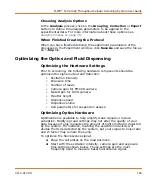
FLIPR
®
Tetra High Throughput Cellular Screening System User Guide
0112-0109 H
179
Conventional protocols for evaluating changes in membrane potential
are technique-sensitive and multi-step procedures consisting of
preparing large batches of dye and introducing dye into the compound
plate. Several problems are routinely encountered with the
conventional methods, all of which add to experimental variability.
Problems in a conventional assay protocol include:
•
Slow response time of traditional dyes used
•
Extensive pre-read soaking procedure
•
Requirement for precise temperature control
•
Variation in fluorescence according to ionic concentrations
Molecular Devices has developed the FLIPR
®
Membrane Potential Assay
Kits to maximize cell line/channel/compound applicability while
eliminating causes of variability in the data and reducing the number of
steps in the conventional protocol.
Advantages of the FLIPR
®
Membrane Potential Assay Kits include:
•
More reproducible data
•
Faster response time
•
No cumbersome pre-assay preparation
•
Ease of use at room temperature to physiological temperatures
•
Fewer steps in the assay resulting in higher sample throughput
Cell Preparation for the FLIPR Membrane Potential
Assay
Cell Densities
A variety of cell handling conditions may be adopted at your discretion
based on standard operating procedures in the laboratory. Non-
adherent cells are typically plated on the day of experiment on a coated
plate (for example
,
poly-d-lysine or collagen) to assist cell adherence to
the plate bottom. We recommend you then centrifuge the plates at
1000 rpm for up to 4 min with the brake off. Adherent cells are seeded
the day prior to an experiment and incubated in a 5% CO
2
, 37 °C
incubator overnight. To create an 80–90% confluent cell monolayer, it
is recommended the cells be seeded at densities shown in the table
below.
Cell Type
(cells/well)
96-well Plate
(100
μ
L
growth
medium)
384-well Plate
(25
μ
L growth
medium)
1536-well
Plate
(4
μ
L growth
medium)
Adherent cells
20,000–80,000
5,000–20,000
1,500–5,000
Non-adherent cells
40,000–200,000 10,000–50,000
3,000–10,000
Содержание FLIPR Tetra
Страница 1: ...FLIPR Tetra High Throughput Cellular Screening System User Guide 0112 0109 H December 2011...
Страница 12: ...Contents 12 0112 0109 H...
Страница 16: ...System Overview 16 0112 0109 H...
Страница 40: ...System Hardware Features 40 0112 0109 H...
Страница 148: ...Exchanging Hardware 148 0112 0109 H...
Страница 156: ...Calibration and Signal Test 156 0112 0109 H...
Страница 196: ...Running an Experiment 196 0112 0109 H...
Страница 232: ...Robotic Integration 232 0112 0109 H The following drawings illustrate these requirements...
Страница 282: ...Data Processing Algorithms 282 0112 0109 H...
Страница 294: ...Consumables and Accessories 294 0112 0109 H...
Страница 298: ...Using AquaMax Sterilant 298 0112 0109 H...
Страница 302: ...Electromagnetic Compatibility EMC 302 0112 0109 H...
















































